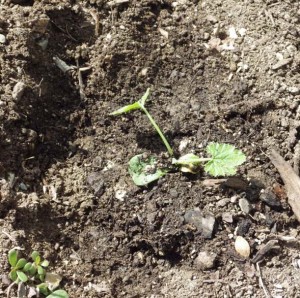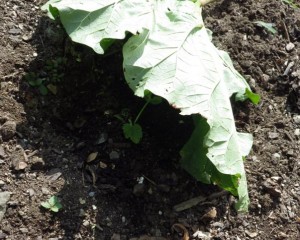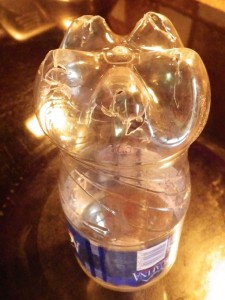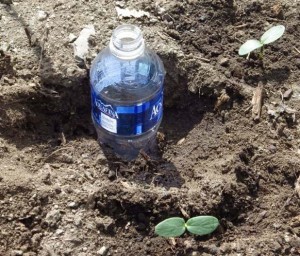 Your Dear Old Aunty is getting mighty tired of reading headlines saying “Hottest (pick your month) Ever!”
Your Dear Old Aunty is getting mighty tired of reading headlines saying “Hottest (pick your month) Ever!”
Well, of course it IS. This is what climate change is all about.
Along with weird winters (we had very little snow this past winter and then in late April, after all the fruit trees were in blossom, WHAM, we had a massive freeze. No apples, cherries, peaches etc. for us.
It also means that rains during the summer are crazy too. What we are getting here in Upstate New York is rather spotty rain. Forty-five minutes north and west from me, up in the Finger Lakes, the grass isn’t brown – it’s crispy. Forty-five minutes north and east of me, moving toward Albany, they’ve had almost 4 inches of rain since the beginning of July.
Life is not fair.
So, gardening is more than a bit of a challenge.
We’ve discussed cover cropping to help hold water in the soil. But here are a couple of tricks I use.
Divots. See photo at the top.
When I plant out seedlings, I press down a pretty big ‘divot’ into the soil around the seedling. This holds extra water when (and if) it rains and if I want to give the seedlings and plants extra water. We use double-dug raised beds and frankly, watering tends to just roll off the sides. Wasteful and not getting the moisture to the veggies (which is the whole point in any case). In the Southwest, traditional dry-land growing uses literally little walls of earth, waffle gardening. Some people even believe the popular ‘square foot garden’ method is a version of this. My version of this is the divot, and it works. Another thing it does is direct the water right next to the plant – where the roots are located. That means I’m not watering soil with no veggies in it. It wastes water, which has become more and more precious and actually feeds weed seeds.
Another thing I do, when I transplant seedlings is provide some shade for the first 24 hours.  Transplanting really is very stressful for seedlings and if the weather is hot and sunny, it’s even more of a shock. In this case, I was cutting back the rhubarb (at this point, the stems of the leaves are woody and no one is interested in it in any case, but the big rigid leaves can be used as shade for my seedlings. (yes, yes, I know – it’s very late for zucchini, but as long as we get some, and you KNOW we’ll get some, we’re ok and they’ll be small, not big enough to throw a saddle on and ride off into the sunset)
Transplanting really is very stressful for seedlings and if the weather is hot and sunny, it’s even more of a shock. In this case, I was cutting back the rhubarb (at this point, the stems of the leaves are woody and no one is interested in it in any case, but the big rigid leaves can be used as shade for my seedlings. (yes, yes, I know – it’s very late for zucchini, but as long as we get some, and you KNOW we’ll get some, we’re ok and they’ll be small, not big enough to throw a saddle on and ride off into the sunset)
A second watering method (and another one borrowed from Southwest native peoples) is the Olla. Now traditionally, these are unglazed clay pots which are buried and refilled on a regular basis to seep moisture through the ground to nearby growing plants.
Now, I don’t happen to have unglazed clay pot with a small neck to bury, but I do have plenty of plastic water bottles. This method is not necessarily as efficient as using an unglazed pot, but the theory is the same.
 Take a plastic beverage bottle and put holes in the bottom. I’m using a 16 ounce water bottle here; if I had something larger, I would. The whole thing is that you need something with a neck that’s narrower than the vessel itself. I’m also going to use the cap, so I’m saving that. As you can see from the photo, I cut holes in the bottom. If you have something more rigid (like a plastic juice jug), you might need to use a nail or something like that.
Take a plastic beverage bottle and put holes in the bottom. I’m using a 16 ounce water bottle here; if I had something larger, I would. The whole thing is that you need something with a neck that’s narrower than the vessel itself. I’m also going to use the cap, so I’m saving that. As you can see from the photo, I cut holes in the bottom. If you have something more rigid (like a plastic juice jug), you might need to use a nail or something like that.
The next step is to bury your bottle next to your plants. I planted out some very short season cucumbers last week and I’m burying the bottle in between them.  I really did not bury this as deeply as I should. The bottle really should be buried deeply enough so that all you can see is the neck. We’ll survive. I filled the bottle and it immediately emptied into the dirt, so I filled it again and this time, it held most of the water. Then I screwed on the top. This will prevent whatever water still in the bottle from evaporating and being lost. I’ll fill this bottle on a regular basis (barring a good solid rainfall, which at this point will need to be at least 1″ in 24 hours) to keep the cucumbers growing. At the end of the growing season, I’ll dig up the bottle and save it for next year.
I really did not bury this as deeply as I should. The bottle really should be buried deeply enough so that all you can see is the neck. We’ll survive. I filled the bottle and it immediately emptied into the dirt, so I filled it again and this time, it held most of the water. Then I screwed on the top. This will prevent whatever water still in the bottle from evaporating and being lost. I’ll fill this bottle on a regular basis (barring a good solid rainfall, which at this point will need to be at least 1″ in 24 hours) to keep the cucumbers growing. At the end of the growing season, I’ll dig up the bottle and save it for next year.
Hope everyone’s gardens are growing well. We’re starting to get peppers and tomatoes now and the garlic is starting the fall over, which means we get to harvest garlic soon!!!
